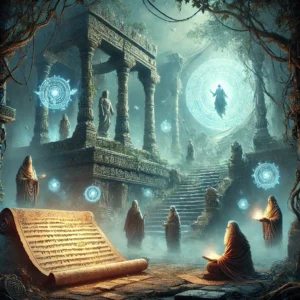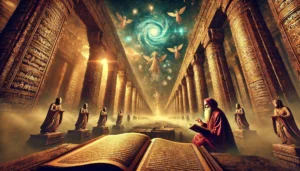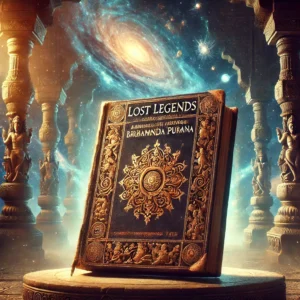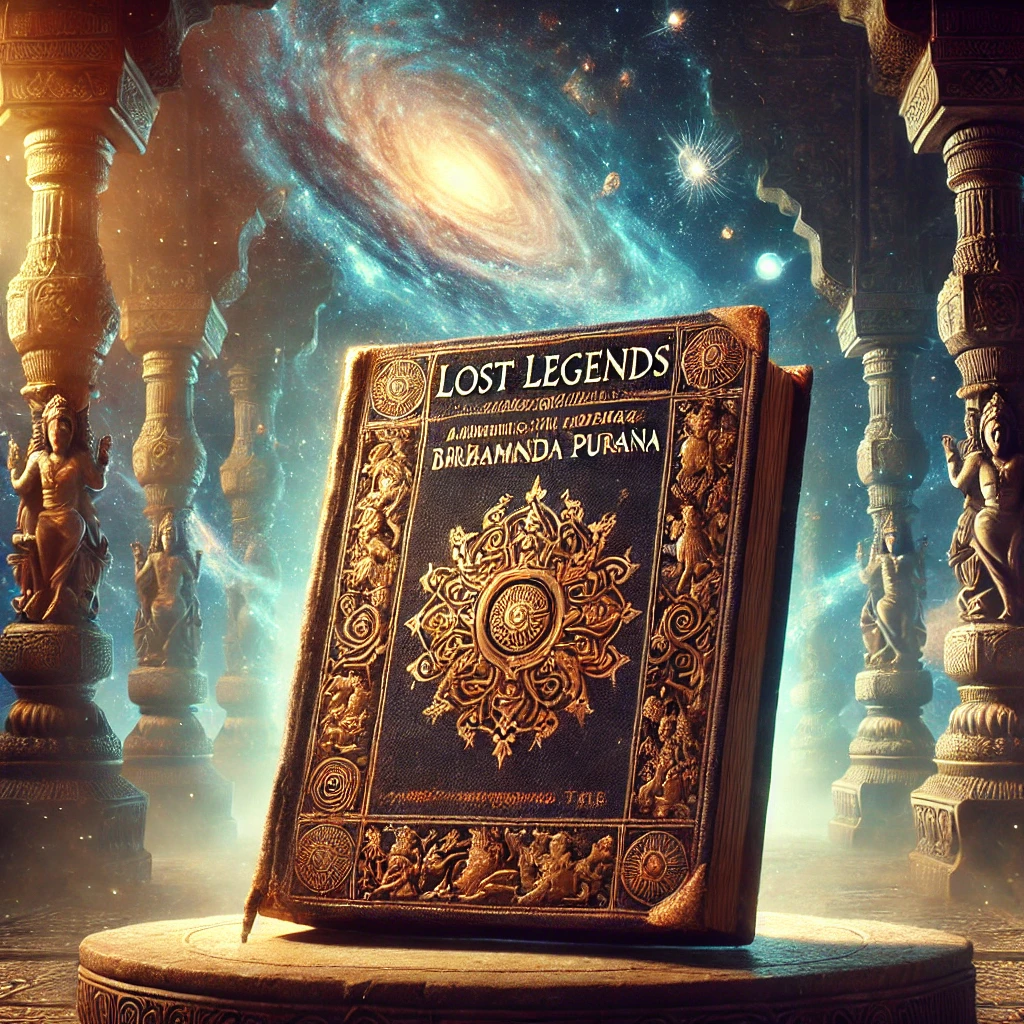
Hidden tales of Brahmanda & Harivamsa puran
Chronicles of Forgotten Epics: Unearthing Hidden Tales from the Harivamsa and Brahmanda Purana
Hindu mythology is a vast ocean, where some narratives shine brightly in popular culture while others remain submerged, waiting to be rediscovered. The Harivamsa and Brahmanda Purana—two lesser-explored texts—contain such hidden gems. The Harivamsa, often considered an appendix to the Mahabharata, details Krishna’s genealogy, cosmic events, and divine battles, while the Brahmanda Purana presents grand cosmological visions, royal lineages, and esoteric spiritual knowledge.
In this article, we explore forgotten tales from these epics—stories that deepen our understanding of celestial conflicts, divine interventions, and the intricate web of fate and karma.
1. King Marutta’s Divine Yajna: A Ritual That Rivaled the Gods
One of the grandest yajnas ever performed was by King Marutta of the Ikshvaku dynasty, detailed in the Brahmanda Purana. Unlike other sacrifices, Marutta’s yajna was so powerful that it nearly disrupted the balance of the three worlds.
Why Was Marutta’s Yajna Unique?
A Mortal’s Ambition to Surpass the Gods: Marutta sought a yajna that would bestow eternal prosperity on his kingdom, unlike any performed before.
Samvarta’s Role: The unpredictable sage Samvarta, the brother of Brihaspati, took charge of the ritual, guiding Marutta through extreme trials.
Divine Attendees: Indra initially opposed the yajna, fearing it would elevate a mortal to god-like status. However, Vishnu, in his cosmic form, secretly blessed it, making it one of the most spiritually potent sacrifices in history.
The yajna’s brilliance was said to illuminate the heavens, forcing even the Devas to acknowledge a mortal king’s might. Yet, as is often the case in Hindu mythology, such supreme acts of dharma also invite cosmic rebalancing. The yajna, though successful, marked the decline of Marutta’s lineage, fulfilling an ancient prophecy.
Table of Contents

Hidden tales of Brahmanda & Harivamsa puran
2. Krishna’s Battle Against Vajranabha: A Celestial Confrontation Beyond the Mahabharata
The Harivamsa narrates a lesser-known battle where Krishna faced an adversary unlike any other—Vajranabha, the solar king. Unlike Kamsa or Jarasandha, Vajranabha was a celestial entity, wielding weapons imbued with the power of the Sun.
The Unique Aspects of This Battle
A Warrior of the Solar Dynasty: Vajranabha, a descendant of Surya, ruled a kingdom beyond the material world, threatening both the Devas and the mortal realm.
Divine Weapons and Cosmic Warfare: Vajranabha’s astras were created by Vishwakarma and were said to emit flares that could incinerate entire armies. Krishna had to counter them with strategic lunar alignments, as solar energy was at its peak during daytime battles.
Yogamaya’s Role: The goddess Yogamaya, often overshadowed in Krishna’s stories, played a crucial role by disrupting Vajranabha’s energy field at key moments, allowing Krishna to strike the decisive blow.
This battle showcases Krishna’s divine strategy, proving that beyond his human form, he was a master of cosmic warfare.
3. The Hidden Role of Garuda: More Than Vishnu’s Mount
Garuda, often seen as merely Vishnu’s vehicle, holds a more profound cosmic role in the Brahmanda Purana. Before serving Vishnu, Garuda undertook immense penances and gained hidden knowledge of the universe.
Garuda’s Forgotten Past
The Celestial Mediator: Before becoming Vishnu’s mount, Garuda acted as a peacekeeper between the Nagas and Gandharvas, preventing a divine war.
The Absorber of Cosmic Energy: The Brahmanda Purana states that Garuda was uniquely capable of absorbing excess cosmic radiations, preventing celestial bodies from destabilizing. This aspect of his existence kept the universe in balance.
The Hidden Vedic Knowledge: Garuda is also said to have learned secrets from the Rig Veda that were even unknown to many sages.
This narrative transforms Garuda from a loyal servant to a cosmic force maintaining dharma.
4. Mandodari’s Birth and Her Link to Alakshmi: A Tragic Fate
Mandodari, the wife of Ravana, is remembered for her wisdom and virtue, yet her origins are shrouded in mystery. The Harivamsa suggests a fascinating link between Mandodari and Alakshmi, the goddess of misfortune.
The Divine Origin of Mandodari
Alakshmi’s Cosmic Rejection: When Alakshmi (the embodiment of inauspiciousness) was expelled from Vaikuntha after Lakshmi emerged from the Samudra Manthan, remnants of her energy were deposited in a celestial lake.
A Child of Destiny: It was from this lake that Mandodari was miraculously born and later adopted by Mayasura, the celestial architect.
Her Unavoidable Tragedy: Despite being pure-hearted, Mandodari’s connection to Alakshmi meant she was fated to suffer misfortune, symbolized by her forced union with Ravana.
This interpretation adds a new layer to Mandodari’s tragedy—she was bound to Ravana not by karma alone but by a divine curse.

Hidden tales of Brahmanda & Harivamsa puran
5. The Fall of Ilvala and Vatapi: A Curse Fulfilled
The demon brothers Ilvala and Vatapi are infamous for their deceitful magic, tricking sages into consuming Vatapi’s flesh, only to resurrect him and kill their victims. However, the Brahmanda Purana expands on their fate beyond what is commonly known.
The Origins of Their Hatred for Brahmins
Ilvala once sought to become a Brahmin but was denied due to his Asuric nature. Enraged, he vowed vengeance against all sages.
Vatapi, his younger brother, had regenerative abilities that made him an ideal tool for their deceptive killings.
The brothers’ rule created a karmic imbalance, causing droughts and suffering across their region.
The Role of Divine Intervention
Sage Agastya, aware of their plot, consumed Vatapi and used his immense yogic power to digest him permanently.
Ilvala’s subsequent death was prophesied, marking the cleansing of a cursed land.
After their demise, the barren land they ruled took centuries to recover, symbolizing nature’s reaction to their misdeeds.
This tale reinforces the idea that cosmic justice operates beyond human perception, punishing even the mightiest wrongdoers.
Conclusion: Why These Forgotten Tales Matter
The Harivamsa and Brahmanda Purana are treasure troves of mythological lore, often overshadowed by the Ramayana and Mahabharata. These forgotten epics provide unique insights into:
The cosmic balance between mortals and gods.
The deeper, often unseen roles of secondary deities and celestial beings.
The inevitability of karma and the cyclical nature of fate.
By revisiting these lesser-known stories, we gain a more holistic understanding of Hindu mythology and its intricate narrative traditions. These epics remind us that mythology is not just a collection of tales but a reflection of cosmic truths, waiting to be rediscovered.
FAQs for “Lost Legends of the Harivamsa and Brahmanda Purana: Unveiling Forgotten Epics”:
Frequently Asked Questions (FAQs)
- What is this series about?
This series delves into the lesser-known legends from the Harivamsa and Brahmanda Purana, uncovering hidden narratives that are often overshadowed by more popular mythological tales. These stories offer unique perspectives on ancient history, cosmology, dharma, and divine lineages.
- Why are the Harivamsa and Brahmanda Purana important?
The Harivamsa is considered an appendix to the Mahabharata, focusing on Krishna’s ancestry, divine deeds, and historical context. The Brahmanda Purana is one of the oldest Maha-Puranas, detailing cosmic creation, dynastic histories, and esoteric knowledge, making both crucial for understanding Indian mythology.
- What kind of stories will be covered in this series?
This series will feature:
Rarely discussed episodes from Krishna’s lineage and interactions with lesser-known figures.
Forgotten dynasties and rulers mentioned in the Puranas.
Mystical accounts of cosmic cycles, celestial beings, and divine interventions.
Unexplored narratives about sages, asuras, and unique avatars.
Esoteric and philosophical insights embedded in these texts.
- Are these stories purely mythological, or do they have historical significance?
While the stories are deeply mythological, many historians and scholars believe they carry traces of historical events, cultural evolution, and philosophical doctrines. The genealogies and regional references in these texts often align with known historical and archaeological findings.
- Who would benefit from reading this series?
This series is ideal for:
Enthusiasts of Indian mythology and storytelling.
Scholars and researchers interested in Puranic literature.
Spiritual seekers exploring the deeper meanings of ancient texts.
Writers and artists looking for inspiration from forgotten tales.
- Will references to original Sanskrit texts be provided?
Yes. Whenever possible, the articles will include relevant Sanskrit verses along with their translations and interpretations. This will help readers connect with the source material and understand the original context.
- How do these stories relate to modern times?
Many of these narratives discuss themes like duty (dharma), cosmic justice (karma), and the cyclical nature of time, which remain relevant today. They offer moral and philosophical insights applicable to personal growth, leadership, and spirituality.
- Are these stories different from those in the Bhagavata Purana or Vishnu Purana?
Yes. While all three Puranas contain stories about Krishna and divine cosmology, the Harivamsa and Brahmanda Purana often present unique versions or additional details that are not found in the Bhagavata or Vishnu Purana.
- How do the Harivamsa and Brahmanda Purana compare to other Puranas?
The Harivamsa acts as a supplement to the Mahabharata, focusing on Krishna’s genealogy and divine deeds.
The Brahmanda Purana is more encyclopedic, covering cosmic cycles, creation myths, royal lineages, and esoteric wisdom.
Unlike devotional Puranas such as the Bhagavata Purana, these texts emphasize history, cosmology, and dynastic narratives.
- Can these texts help in spiritual growth?
Yes. The stories often contain deeper symbolic meanings related to spiritual evolution, cosmic order, and self-realization. By studying these forgotten epics, readers can gain new perspectives on life’s purpose and the workings of divine will.
- Will the series include comparative analysis with other ancient texts?
Where relevant, the series will compare these stories with references from the Mahabharata, Ramayana, other Puranas, and even non-Indian mythological traditions to provide a broader understanding.
- How often will new content be published?
New articles will be published regularly on Prachin Sanaran Yuga. Readers can subscribe to our newsletter for updates and exclusive insights.
- Can readers request specific topics or stories to be covered?
Yes! If you have a particular story, character, or theme from the Harivamsa or Brahmanda Purana that you’d like to explore, feel free to suggest it in the comments or through our contact page.
- How can I support this project?
You can support us by:
Sharing our content with fellow mythology enthusiasts.
Engaging with our posts through comments and discussions.
Following Prachin Sanaran Yuga on social media.
Contributing through voluntary donations if you wish to support in-depth research.
- How can I stay updated with the series?
Follow our blog Prachin Sanaran Yuga for regular updates, or subscribe to our newsletter for notifications on new posts.
Summary
Lost Legends of the Harivamsa and Brahmanda Purana: Unveiling Forgotten Epics
The vast corpus of Hindu Puranic literature contains countless stories of cosmic creation, divine incarnations, and heroic exploits, yet many of its lesser-known narratives remain obscured by time. While the Mahabharata and Ramayana have shaped the spiritual and cultural consciousness of India, texts like the Harivamsa and Brahmanda Purana hold hidden gems—stories that offer fresh perspectives on the cosmic order, divine interventions, and human virtues. This article delves into these overlooked epics, shedding light on forgotten tales that deserve renewed attention.
The Harivamsa, often considered an appendix to the Mahabharata, expands upon Krishna’s divine lineage and early life beyond what is commonly known. It contains narratives of his celestial ancestry, untold battles, and interactions with enigmatic sages and deities. Beyond Krishna, the text also recounts rare tales of solar and lunar dynasties, the struggles of kings who shaped history, and episodes that bridge the Vedic and Puranic traditions.
The Brahmanda Purana, one of the eighteen Mahapuranas, offers an extensive cosmology, chronicling the universe’s cyclical creation and destruction. Within its pages lie fascinating but less-discussed myths, such as alternative accounts of cosmic deluges, the rise and fall of lost dynasties, and esoteric teachings on time and destiny. This text also contains detailed descriptions of sacred geography, celestial beings, and divine manifestations that deepen our understanding of Sanatana Dharma’s spiritual framework.
By revisiting these forgotten epics, we uncover narratives that challenge conventional retellings, introduce lesser-known heroes and villains, and provide nuanced insights into dharma, karma, and cosmic order. These tales not only enrich our appreciation of Hindu mythology but also inspire contemporary seekers to explore their spiritual and historical roots more deeply.
This exploration into the Harivamsa and Brahmanda Purana invites readers to rediscover the lost legends of ancient India—stories that, though rarely discussed, hold the wisdom of ages waiting to be unveiled.
Related Articles
- Restful Nights: Ayurvedic Remedies and Traditional Indian Practices to Overcome Insomnia and Late-Night Habits
- The Tridevi: Lakshmi, Saraswati, and Parvati – Their Roles and Powers
- “Divine Creatures of Ancient Indian Scriptures: Exploring the Role of Animals in the Vedas, Puranas, and Mahabharata”
- Nature and Spirituality: Exploring the Sacred Essence of the Himalayas, Ganga, and Other Natural Wonders”
- “Reviving the Gurukul System: Relevance and Lessons for Modern Education”
- “Exploring Greek and Indian Mythology: Similarities Between Greek and Indian Mythology “
- “Embracing Sattvic Living: Harmonizing Mind, Body, and Soul Through Food and Lifestyle”
- “Charity and Prosperity: Exploring the Concept of Daan and Its Financial Relevance in Modern Life”
- How to Build an Eco-Friendly Home Inspired by Vastu Shastra
- Comparison of Ancient and Modern Sports: How Traditional Sports Have Influenced Contemporary Games
- “Timeless Lessons from Ancient Tales: Linking Samudra Manthan and Ganga’s Descent to Modern Ecological Challenges”
- “Reviving Sanskrit: How AI is Preserving Ancient Languages for the Future”
- “Mathura: The Sacred Land of Lord Krishna’s Divine Leelas”
- Investing for Future Generations: Lessons from Indian Traditions on Legacy Building and Wealth Preservation
- “Ancient Indian Wisdom: Timeless Lessons for Tackling Today’s Climate Crisis”
- “Artificial Intelligence and Spirituality: Transforming Ancient Practices for the Modern World”
- “Gold and Real Estate in India: Timeless Assets Shaping Financial Strategies”
- Tradition Meets Innovation: The Evolution of Technology in Hindu Rituals
- End-of-World Myths: Exploring Kali Yuga in Hinduism and Ragnarök in Norse Mythology
- Garuda, Pegasus, and Dragons: The Universal Ties of Mythical Beasts Across Cultures
- “Ancient Vimanas: Mythical Flying Machines or Evidence of Advanced Technology?”
- Time Travel in Hindu Mythology: The Fascinating Tales of Kakudmi and King Raivata
- “Divine Feminine Power in Hindu Mythology: The Legends of Durga, Saraswati, and Lakshmi”
- “Divine Beings of Sanatan Dharma: The Spiritual Significance of Sacred Animals in Hinduism”
- “Symbolism in Mythological Art: Unlocking Hidden Meanings in Ancient Temple Carvings”
- “Exploring Technological Advancements in Ancient India and Civilizations: Vimana, Metallurgy, & Water Management systems”
- Unveiling the Mysteries: Ancient Temples of Sanatan Dharma , Mysterious Temples of India
- “The Scientific Knowledge of Sanatan Dharma: Ancient Wisdom Meets Modern Science”
- Ancient Indian Sports and Games: Celebrating a Legacy of Skill, Strength & Strategy”
- “Exploring the Cosmic Link: The Connection Between Astronomy and Vedic Astrology”
- The Power of Sanskrit: Unlocking the Divine Language of the Gods
- “The End of Kaliyuga: A Sanatan Insight into the World’s Final Chapter”
- Explore more articles on Prachin Sanatan Yuga.
Unlock the Ancient Wisdom of Sanatan Dharma – Join Us on YouTube!
👉 Subscribe now to Prachin Sanatan Dharma and embark on a journey of enlightenment.
Explore timeless teachings, spiritual insights, and cultural richness on our YouTube channel, Prachin Sanatan Dharma. Dive deep into the essence of Sanatan Dharma through captivating videos that inspire and educate.
Hidden tales of Brahmanda & Harivamsa puran Hidden tales of Brahmanda & Harivamsa puran Hidden tales of Brahmanda & Harivamsa puran Hidden tales of Brahmanda & Harivamsa puran Hidden tales of Brahmanda & Harivamsa puran Hidden tales of Brahmanda & Harivamsa puran Hidden tales of Brahmanda & Harivamsa puran Hidden tales of Brahmanda & Harivamsa puran
Hidden tales of Brahmanda & Harivamsa puran Hidden tales of Brahmanda & Harivamsa puran Hidden tales of Brahmanda & Harivamsa puran Hidden tales of Brahmanda & Harivamsa puran Hidden tales of Brahmanda & Harivamsa puran Hidden tales of Brahmanda & Harivamsa puran Hidden tales of Brahmanda & Harivamsa puran Hidden tales of Brahmanda & Harivamsa puran
Hidden tales of Brahmanda & Harivamsa puran Hidden tales of Brahmanda & Harivamsa puran Hidden tales of Brahmanda & Harivamsa puran Hidden tales of Brahmanda & Harivamsa puran Hidden tales of Brahmanda & Harivamsa puran Hidden tales of Brahmanda & Harivamsa puran Hidden tales of Brahmanda & Harivamsa puran Hidden tales of Brahmanda & Harivamsa puran
